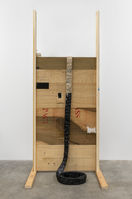RIVKA LEVI
FOG
CURATOR: HADAS MAOR
"When I paint, it is the only moment in which I dwell in the
interval between thoughts; it is a timeless silence."
Rivka Levi
"Fog" Exhibition Text - Hadas Maor
The exhibition Fog spans various types of works. Large sheets of fabric hang loosely on the walls. A makeshift structure stands in the space, pieces of white fabric overlapping it. Another sheet of fabric, stiffened by paint, shriveled, is suspended, as if from a gallows. The exhibition space carries an ambience at once delicate and harsh: the works' soft surfaces, the loose fabric which is not stretched on a frame, sometimes pleated or puffed up and padded, alongside the tough, even violent painterly act, and the emotional difficulty it evokes. The series of works featured in the exhibition was mostly created on blankets and fabric sheets produced by Sukkot Yerushalayim (specializing in booths for the Feast of Tabernacles), which come in pre-set sizes, like portable walls. Rivka Levi works on them with mixed media, including industrial paint and acrylic paint, but also with additional materials, such as airy muslin (cloth diapers). Various signs on the fabric sheets hint at possible functional aspects—a loop, a zipper, netting, Velcro strips. Rather than converging into a specific organizational order, however, they appear as if unconsciously, at random, by surprise; as a bare testimony or as a thought that surfaced abruptly and took hold. Levi's work process combines intention and chance. Figurative touches are hidden by dense, rough blots. The use of industrial paint, which dries slowly and has sealant and protective properties, blends a sense of exterior and interior, preservation and burial. The recurring squares, which originate in the geometric structure of the sukkah, the quilt stitching pattern, or the repeating pattern of artificial sweetener sachets, also echoes the basic pattern of floor tiles, one that Levi associates with a fundamental sense of stability and security, which a home is supposed to provide. This stability, however, hovers in the exhibition space as an open question. In Green Tent (2022), Levi used a tent cover—a fabric intended to offer additional protection, like a house for the temporary house; in a planned, measured modernist act, she cut it into uniformly-sized rectangles resembling cinder blocks. She then reconnected the fabric rectangles in a multi-layered, intuitive, unregulated manner; a mobile home, which is disassembled and reassembled, offering a mental rather than a physical Home. In her seminal work Everyone I have Ever Slept with 1963–1995 (1995), British artist Tracey Emin presented a tent, which became a conduit of direct testimony, appliquéd with the names of the 102 people with whom she shared her bed as of 1995. In Levi's case, the tent functions as a generic, principled, potential signifier of isolation and protection, but despite the differences, in both cases the work presents an absent body in the space. The work Echo (2024), made on sukkah sheets, combines different layers of work: conceptual use of a readymade surface, with its myriad signs and imprints, and the expressive work thereon. The bottom part of the work shows conspicuous signs of creasing, at times resembling a theatrical curtain which hides an event taking place behind it. Net to them, one may Portable Walls | Hadas Maor identify the application of paint at varying degrees of dilution and absorption, ranging from watercolor transparency to opaqueness, including spattered industrial paint, which creates drawn lines. External, bandage-like straps of fabric, combined into the surface, echo and momentarily replace the very act of painting in a free movement between the two-dimensional and the three-dimensional. The engagement with aspects of covering, wrapping, and protection, but also of suffocation and injury, may be traced to the outset of Levi's practice. Created upon her graduation from the Basis College of Art and Culture, the work Gloves (2021) was spawned by thoughts about immigration from Morocco to Israel, the concept of drudgery ("black work" in Hebrew) and black consciousness in general. The use of black latex gloves generated a double layer of blackness—pertaining to both skin tone and hard, arduous work. The material excess, which appears to well forth, evokes a dual sense of attraction and repulsion, calling to mind the work of artists such as Nelly Agassi or Delcy Morelos. All the Time and All Over (2021), presented as an artist wall at Maya Gallery that year, was created during the COVID-19 period. It was made through an act simulating knitting, without the use of mechanical or manual knitting means; an act that echoes binding, sealing, isolation, locking—a distortion of a traditional female craft which relies on a strategy of excess. Whether she works with the material directly or works on it as a mere surface, Levi charges her essentially abstract works with meanings related to the concept of home and the consciousness of a vulnerable body in need of protection.
Rivka Levi
E-Mail: rivka@rivkalevi.com
Tel: 972 54-248-2935








